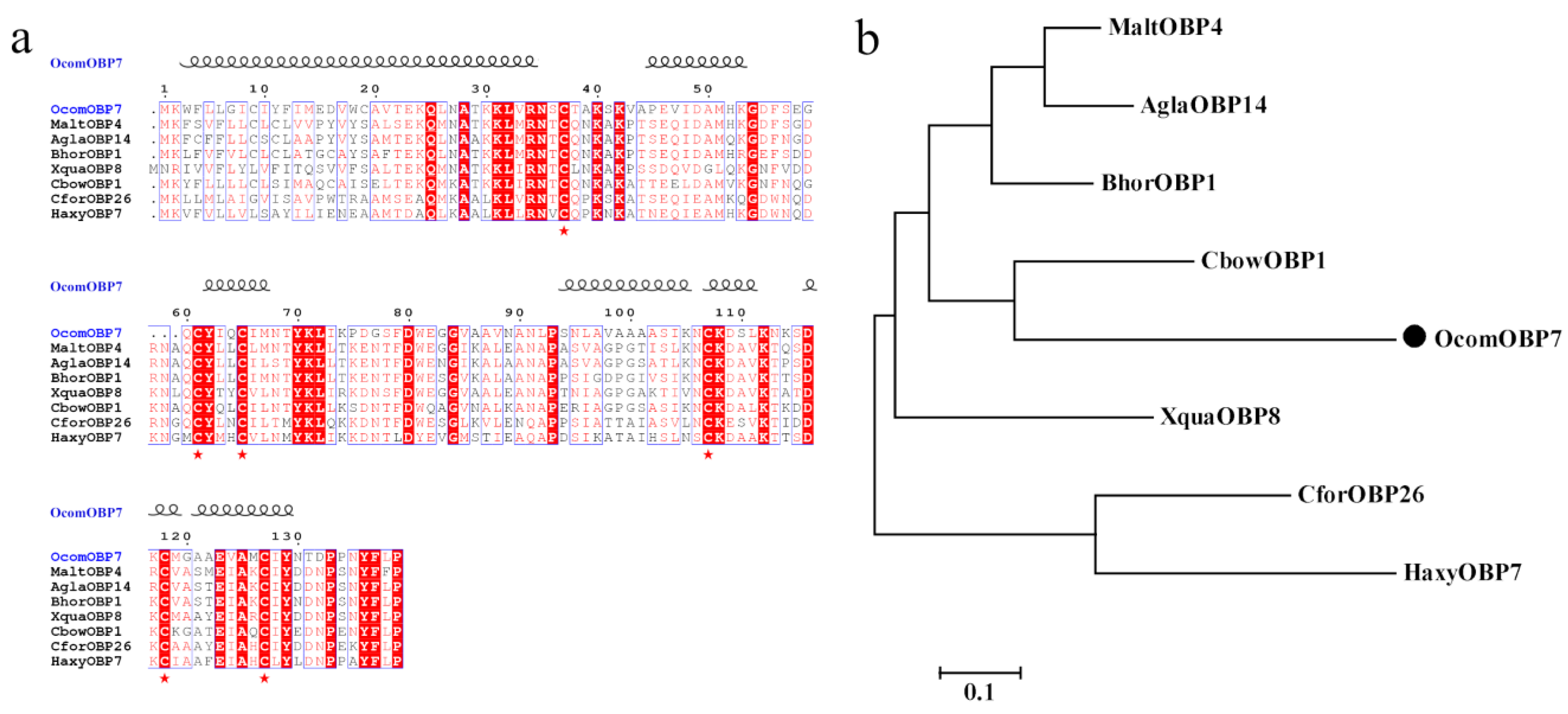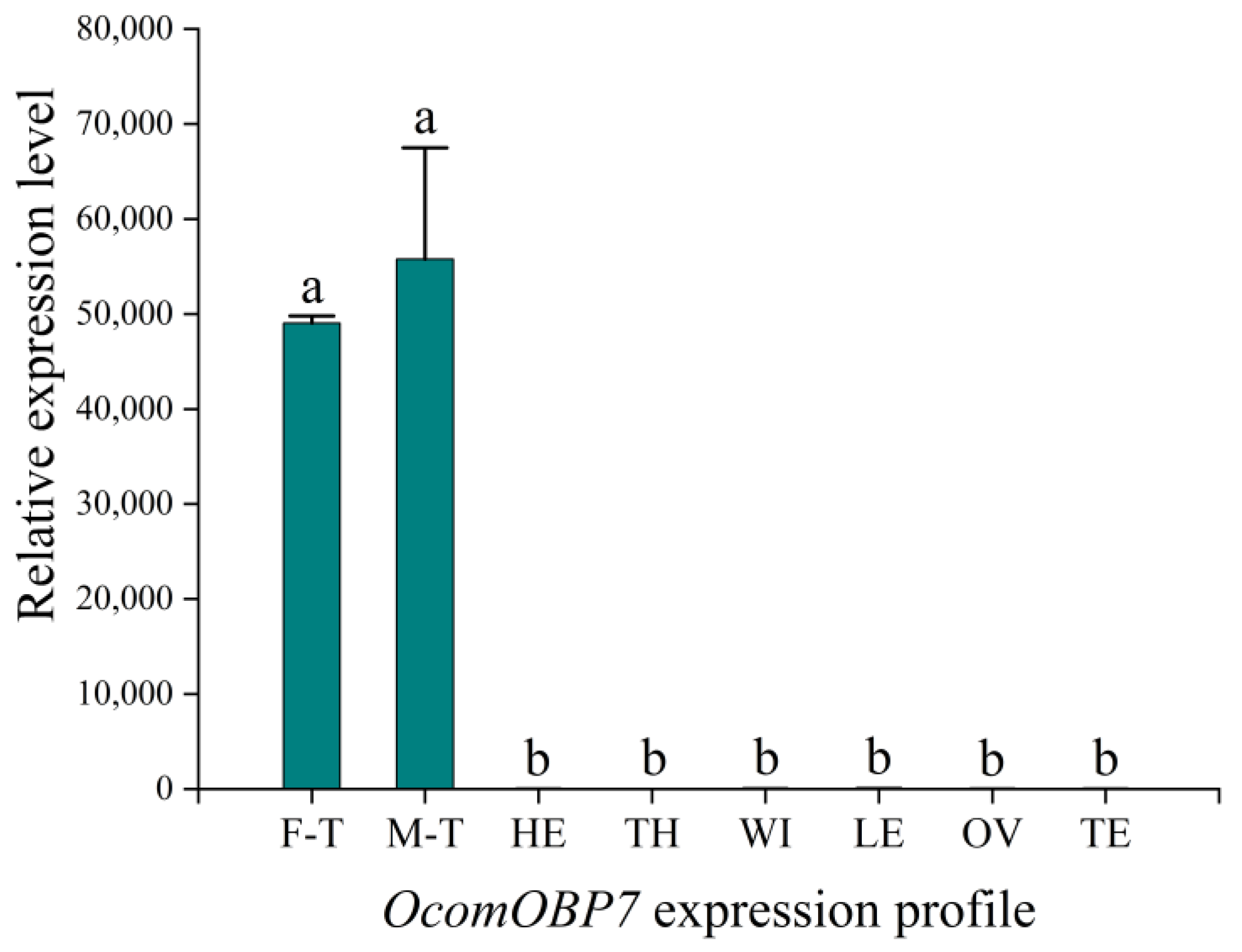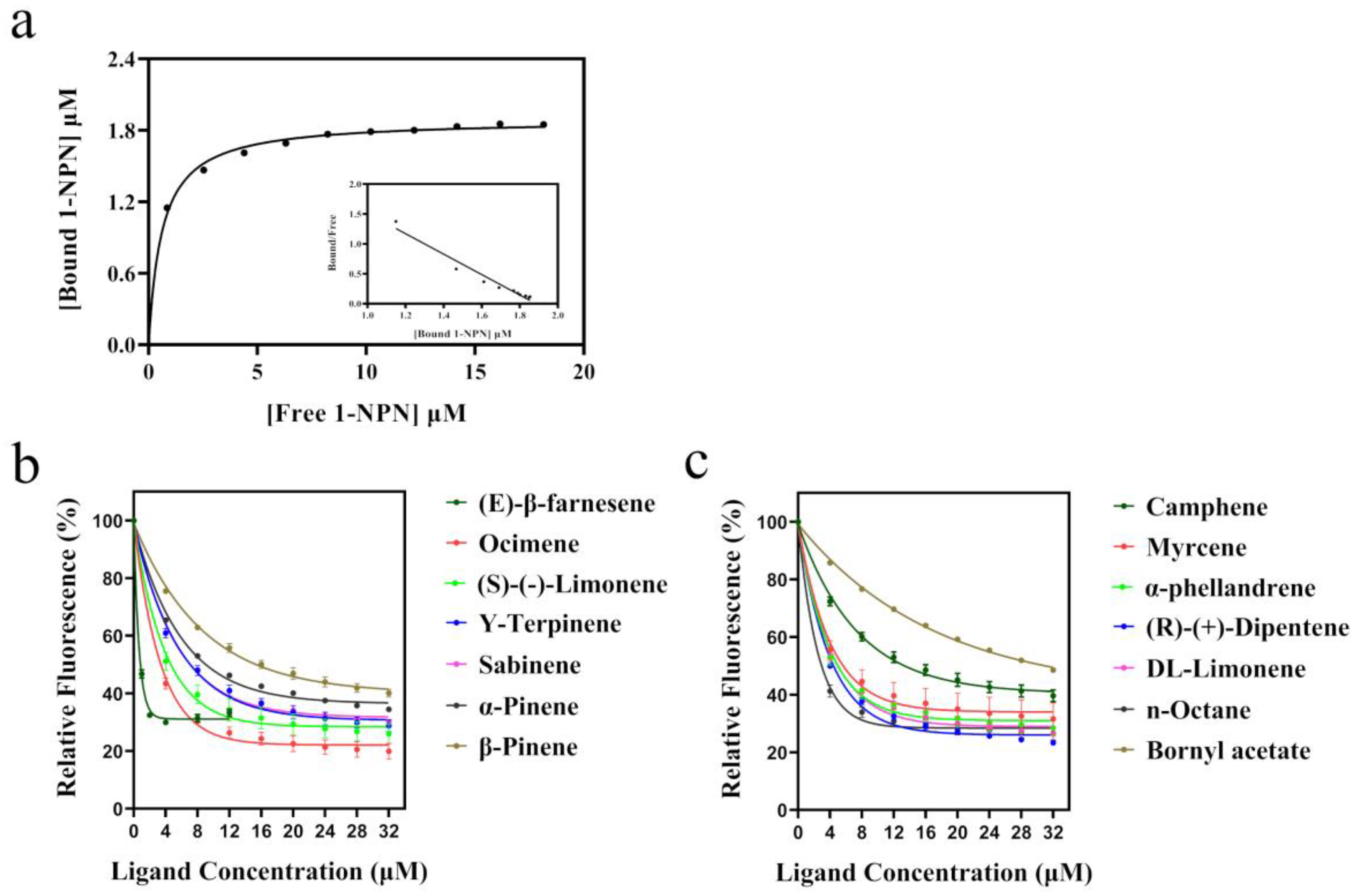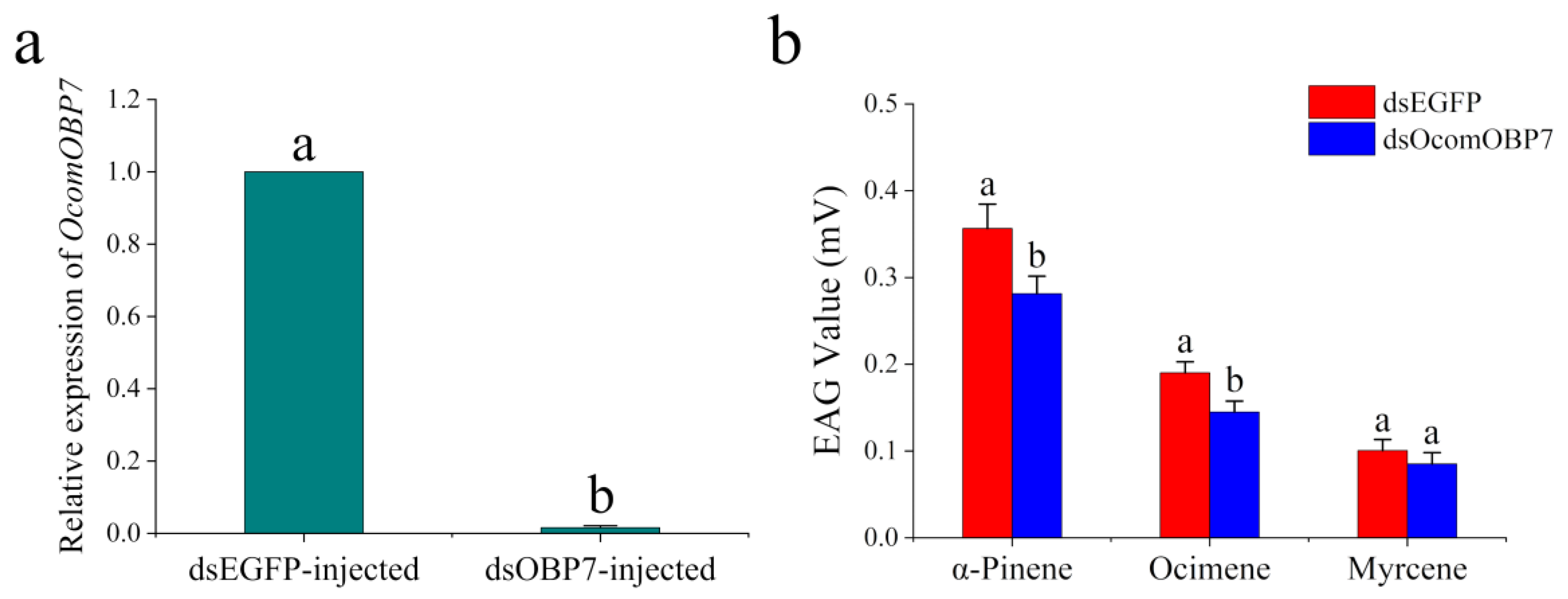Characterization and Functional Analysis of OcomOBP7 in Ophraella communa Lesage
Abstract
Simple Summary
Abstract
1. Introduction
2. Materials and Methods
2.1. Insect Source
2.2. Gene Cloning and Sequence Analysis
2.3. Quantitative Real-Time PCR Analysis
2.4. Heterologous Expression and Purification of OcomOBP7
2.5. Fluorescence Binding Assay
2.6. RNAi-Mediated Gene Silencing
2.7. Electrophysiological Recordings
2.8. Statistical Analysis
3. Results
3.1. Clone and Sequence Analysis of OcomOBP7
3.2. Expression Profiles of OcomOBP7
3.3. Expression and Purification of OcomOBP7
3.4. Ligand-Binding Characteristic of OcomOBP7
3.5. RNAi and EAG Analysis
4. Discussion
5. Conclusions
Supplementary Materials
Author Contributions
Funding
Data Availability Statement
Acknowledgments
Conflicts of Interest
References
- Smith, M.; Cecchi, L.; Skjøth, C.A.; Karrer, G.; Šikoparija, B. Common ragweed: A threat to environmental health in Europe. Environ. Int. 2013, 61, 115–126. [Google Scholar] [CrossRef]
- Han, C.; Shao, H.; Zhou, S.; Mei, Y.; Cheng, Z.; Huang, L.; Lv, G. Chemical composition and phytotoxicity of essential oil from invasive plant, Ambrosia artemisiifolia L. Ecotoxicol. Environ. Saf. 2021, 211, 111879. [Google Scholar] [CrossRef] [PubMed]
- Zhou, Z.S.; Chen, H.S.; Zheng, X.W.; Guo, J.Y.; Guo, W.; Li, M.; Luo, M.; Wan, F.H. Control of the invasive weed Ambrosia artemisiifolia with Ophraella communa and Epiblema strenuana. Biocontrol Sci. Tech. 2014, 24, 950–964. [Google Scholar] [CrossRef]
- He, P.; Durand, N.; Dong, S.L. Editorial: Insect olfactory proteins (from gene identification to functional characterization). Front. Physiol. 2019, 10, 1313. [Google Scholar] [CrossRef] [PubMed]
- Pelosi, P.; Iovinella, I.; Zhu, J.; Wang, G.; Dani, F.R. Beyond chemoreception: Diverse tasks of soluble olfactory proteins in insects. Biol. Rev. Camb. Philos. Soc. 2018, 93, 184–200. [Google Scholar] [CrossRef]
- Leal, W.S. Odorant reception in insects: Roles of receptors, binding proteins, and degrading enzymes. Annu. Rev. Entomol. 2013, 58, 373–391. [Google Scholar] [CrossRef] [PubMed]
- Fleischer, J.; Pregitzer, P.; Breer, H.; Krieger, J. Access to the odor world: Olfactory receptors and their role for signal transduction in insects. Cell Mol. Life Sci. 2018, 75, 485–508. [Google Scholar] [CrossRef]
- Ahmed, T.; Zhang, T.; Wang, Z.; He, K.; Bai, S. Molecular cloning, expression profile, odorant affinity, and stability of two odorant-binding proteins in Macrocentrus cingulum Brischke (Hymenoptera: Braconidae). Arch. Insect Biochem. Physiol. 2017, 94, 10. [Google Scholar] [CrossRef]
- Vieira, F.G.; Rozas, J. Comparative genomics of the odorant-binding and chemosensory protein gene families across the Arthropoda: Origin and evolutionary history of the chemosensory system. Genome Biol. Evol. 2011, 3, 476–490. [Google Scholar] [CrossRef]
- Wang, J.; Gao, P.; Luo, Y.; Tao, J. Characterization and expression profiling of odorant-binding proteins in Anoplophora glabripennis Motsch. Gene 2019, 693, 25–36. [Google Scholar] [CrossRef]
- Pelosi, P.; Zhou, J.J.; Ban, L.P.; Calvello, M. Soluble proteins in insect chemical communication. Cell Mol. Life Sci. 2006, 63, 1658–1676. [Google Scholar] [CrossRef]
- Briand, L.; Nespoulous, C.; Huet, J.C.; Pernollet, J.C. Disulfide pairing and secondary structure of ASP1, an olfactory-binding protein from honeybee (Apis mellifera L.). J. Pept. Res. 2001, 58, 540–545. [Google Scholar] [CrossRef] [PubMed]
- Pechlaner, M.; Oostenbrink, C. Multiple binding poses in the hydrophobic cavity of bee odorant binding protein AmelOBP14. J. Chem. Inf. Model. 2015, 55, 2633–2643. [Google Scholar] [CrossRef]
- Vogt, R.G.; Riddiford, L.M. Pheromone binding and inactivation by moth antennae. Nature 1981, 293, 161–163. [Google Scholar] [CrossRef] [PubMed]
- Rihani, K.; Ferveur, J.F.; Briand, L. The 40-year mystery of insect odorant-binding proteins. Biomolecules 2021, 11, 509. [Google Scholar] [CrossRef]
- Chang, H.; Liu, Y.; Yang, T.; Pelosi, P.; Dong, S.; Wang, G. Pheromone binding proteins enhance the sensitivity of olfactory receptors to sex pheromones in Chilo suppressalis. Sci. Rep. 2015, 5, 13093. [Google Scholar] [CrossRef]
- Swarup, S.; Williams, T.I.; Anholt, R.R. Functional dissection of odorant binding protein genes in Drosophila melanogaster. Genes Brain Behav. 2011, 10, 648–657. [Google Scholar] [CrossRef]
- Yasukawa, J.; Tomioka, S.; Aigaki, T.; Matsuo, T. Evolution of expression patterns of two odorant-binding protein genes, Obp57d and Obp57e, in Drosophila. Gene 2010, 467, 25–34. [Google Scholar] [CrossRef]
- Liu, H.; Wang, C.; Qiu, C.L.; Shi, J.H.; Sun, Z.; Hu, X.J.; Liu, L.; Wang, M.Q. A salivary odorant-binding protein mediates Nilaparvata lugens feeding and host plant phytohormone suppression. Int. J. Mol. Sci. 2021, 22, 4988. [Google Scholar] [CrossRef] [PubMed]
- Jeong, Y.T.; Shim, J.; Oh, S.R.; Yoon, H.I.; Kim, C.H.; Moon, S.J.; Montell, C. An odorant-binding protein required for suppression of sweet taste by bitter chemicals. Neuron 2013, 79, 725–737. [Google Scholar] [CrossRef]
- List, F.; Tarone, A.M.; Zhu-Salzman, K.; Vargo, E.L. RNA meets toxicology: Efficacy indicators from the experimental design of RNAi studies for insect pest management. Pest. Manag. Sci 2022, 78, 3215–3225. [Google Scholar] [CrossRef] [PubMed]
- Ma, C.; Zhao, C.; Cui, S.; Zhang, Y.; Zhou, Z. Identification of candidate chemosensory genes of Ophraella communa lesage (coleoptera: Chrysomelidae) based on antennal transcriptome analysis. Sci. Rep. 2019, 9, 15551. [Google Scholar] [CrossRef] [PubMed]
- Chalchat, J.C.; Maksimović, Z.A.; Petrović, S.D.; Gorunović, M.S.; Dordević, S.; Mraović, M. Chemical composition and antimicrobial activity of Ambrosia artemisiifolia L. essential oil. J. Essent Oil Res. 2004, 16, 270–273. [Google Scholar] [CrossRef]
- Ma, T.; Liu, Z.T.; Zhang, Y.Y.; Sun, Z.H.; Li, Y.Z.; Wen, X.J.; Chen, X.Y. Electrophysiological and behavioral responses of Diaphania glauculalis males to female sex pheromone. Environ. Sci. Pollut. Res. Int. 2015, 22, 15046–15054. [Google Scholar] [CrossRef] [PubMed]
- Zehraoui, A.; Hassan, A.A.; Sorial, G.A. Effect of methanol on the biofiltration of n-hexane. J. Hazard. Mater. 2012, 219–220, 176–182. [Google Scholar] [CrossRef]
- Fan, J.; Francis, F.; Liu, Y.; Chen, J.L.; Cheng, D.F. An overview of odorant-binding protein functions in insect peripheral olfactory reception. Genet. Mol. Res. 2011, 10, 3056–3069. [Google Scholar] [CrossRef]
- Sims, C.; Birkett, M.A.; Withall, D.M. Enantiomeric discrimination in insects: The role of OBPs and ORs. Insects 2022, 13, 368. [Google Scholar] [CrossRef] [PubMed]
- Pelletier, J.; Leal, W.S. Genome analysis and expression patterns of odorant-binding proteins from the Southern House mosquito Culex pipiens quinquefasciatus. PLoS ONE 2009, 4, e6237. [Google Scholar] [CrossRef]
- Li, T.T.; Liu, W.C.; Zhu, J.; Yang, Y.H.; Ma, C.; Lu, C.; Zhang, K.X. Crystal structure and ligand identification of odorant binding protein 4 in the natural predator Chrysopa pallens. Int. J. Biol. Macromol. 2019, 141, 1004–1012. [Google Scholar] [CrossRef]
- Tian, L.; Guo, H.G.; Ren, Z.G.; Zhang, A.H.; Qin, X.C.; Zhang, M.Z.; Du, Y.L. Ligand-binding specificities of four odorant-binding proteins in Conogethes punctiferalis. Arch. Insect Biochem. Physiol. 2022, 111, e21947. [Google Scholar] [CrossRef]
- He, P.; Zhang, J.; Liu, N.Y.; Zhang, Y.N.; Yang, K.; Dong, S.L. Distinct expression profiles and different functions of odorant binding proteins in Nilaparvata lugens Stål. PLoS ONE 2011, 6, e28921. [Google Scholar] [CrossRef]
- Sun, L.; Wang, Q.; Wang, Q.; Dong, K.; Xiao, Y.; Zhang, Y.J. Identification and characterization of odorant binding proteins in the forelegs of Adelphocoris lineolatus (Goeze). Front. Physiol. 2017, 8, 735. [Google Scholar] [CrossRef] [PubMed]
- Zhu, J.; Zaremska, V.; D’Onofrio, C.; Knoll, W.; Pelosi, P. Site-directed mutagenesis of odorant-binding proteins. Method Enzymol. 2020, 642, 301–324. [Google Scholar]
- Li, H.L.; Song, X.M.; Wu, F.; Qiu, Y.L.; Fu, X.B.; Zhang, L.Y.; Tan, J. Chemical structure of semiochemicals and key binding sites together determine the olfactory functional modes of odorant-binding protein 2 in Eastern honey bee, Apis cerana. Int. J. Biol. Macromol. 2020, 145, 876–884. [Google Scholar] [CrossRef] [PubMed]
- D’Onofrio, C.; Zaremska, V.; Zhu, J.; Knoll, W.; Pelosi, P. Ligand-binding assays with OBPs and CSPs. Methods Enzymol. 2020, 642, 229–258. [Google Scholar] [PubMed]
- Fraga, B.M. Natural sesquiterpenoids. Nat. Prod. Rep. 2012, 29, 1334–1366. [Google Scholar] [CrossRef] [PubMed]
- Zhao, H.; Peng, Z.; Huang, L.; Zhao, S.; Liu, M. Expression profile and ligand screening of a putative odorant-binding protein, AcerOBP6, from the Asian honeybee. Insects 2021, 12, 955. [Google Scholar] [CrossRef]
- Adeyinka, O.S.; Riaz, S.; Toufiq, N.; Yousaf, I.; Bhatti, M.U.; Batcho, A.; Olajide, A.A.; Nasir, I.A.; Tabassum, B. Advances in exogenous RNA delivery techniques for RNAi-mediated pest control. Mol. Biol. Rep. 2020, 47, 6309–6319. [Google Scholar] [CrossRef]




| Gene Name | Primer Name | Primer Sequence (5′-3′) |
|---|---|---|
| OcomOBP7 | OcomOBP7-F | ATGAAGTGGTTCCTGCTT |
| OcomOBP7-R | TTATGGAAGGAAATAATTTG | |
| OcomOBP7-F-q | GAAAAACAATTAAATGCGACCA | |
| OcomOBP7-R-q | ACCTTCCCAATCAAACGACC | |
| OcomOBP7-eF | GGATCCGCAGTTACAGAAAAACAAT | |
| OcomOBP7-eR | AAGCTTTTATGGAAGGAAATAATTTG | |
| dsOcomOBP7 | dsOcomOBP7-F | TAATACGACTCACTATAGGGATGGAAGATGTATGGTGTG |
| dsOcomOBP7-R | TAATACGACTCACTATAGGGAAGGAAATAATTTGGAGG | |
| dsEGFP | dsEGFP-F | TAATACGACTCACTATAGGGTGAGCAAGGGCGAGGAG |
| dsEGFP-R | TAATACGACTCACTATAGGGCGGCGGTCACGAACTCCAG | |
| RL19 | RL19-F-q | AAGGAAGGCATTGTGGAT |
| RL19-R-q | GACGCAAATCTCGCATAC |
| CAS Number | Name of Compound | IC50 (μM) | Ki (μM) | |
|---|---|---|---|---|
| Alkenes | 18794-84-8 | (E)-β-farnesene | 0.76 | 0.48 ± 0.04 |
| 13877-91-3 | Ocimene | 1.94 | 1.23 ± 0.11 | |
| 5989-54-8 | (S)-(-)-Limonene | 4.02 | 2.55 ± 0.40 | |
| 99-85-4 | Y-Terpinene | 7.42 | 4.70 ± 0.32 | |
| 3387-41-5 | Sabinene | 7.49 | 4.75 ± 0.14 | |
| 80-56-8 | α-Pinene | 10.34 | 6.55 ± 0.05 | |
| 2437-95-8 | β-Pinene | 17.18 | 10.88 ± 0.59 | |
| 87-44-5 | β-Caryophyllene | - | - | |
| 6753-98-6 | α-Humulene | - | - | |
| 565-00-4 | Camphene | 15.54 | 9.85 ± 0.66 | |
| 123-35-3 | Myrcene | 6.26 | 3.97 ± 0.85 | |
| 99-83-2 | α-phellandrene | 4.59 | 2.91 ± 0.42 | |
| 5989-27-5 | (R)-(+)-Dipentene | 3.50 | 2.22 ± 0.11 | |
| 124-76-5 | Isoborneol | - | - | |
| 464-49-3 | Camphor | - | - | |
| 138-86-3 | DL-Limonene | 4.48 | 2.84 ± 0.20 | |
| Alkanes | 112-40-3 | n-Dodecane | - | - |
| 629-50-5 | n-Tridecane | - | - | |
| 111-65-9 | n-Octane | 1.05 | 0.67 ± 0.12 | |
| Esters | 3681-71-8 | cis-3-Hexenyl Acetate | - | - |
| 125-12-2 | Isobornyl acetate | - | - | |
| 76-49-3 | Bornyl acetate | 32.16 | 20.37 ± 0.07 | |
| Aldehydes | 124-13-0 | Octanal | - | - |
| 124-19-6 | 1-Nonanal | - | - | |
| Alcohols | 78-70-6 | Linalool | - | - |
| 18479-58-8 | Dihydromyrcenol | - | - |
Disclaimer/Publisher’s Note: The statements, opinions and data contained in all publications are solely those of the individual author(s) and contributor(s) and not of MDPI and/or the editor(s). MDPI and/or the editor(s) disclaim responsibility for any injury to people or property resulting from any ideas, methods, instructions or products referred to in the content. |
© 2023 by the authors. Licensee MDPI, Basel, Switzerland. This article is an open access article distributed under the terms and conditions of the Creative Commons Attribution (CC BY) license (https://creativecommons.org/licenses/by/4.0/).
Share and Cite
Yue, Y.; Ma, C.; Zhang, Y.; Chen, H.-S.; Guo, J.-Y.; Liu, T.-H.; Zhou, Z.-S. Characterization and Functional Analysis of OcomOBP7 in Ophraella communa Lesage. Insects 2023, 14, 190. https://doi.org/10.3390/insects14020190
Yue Y, Ma C, Zhang Y, Chen H-S, Guo J-Y, Liu T-H, Zhou Z-S. Characterization and Functional Analysis of OcomOBP7 in Ophraella communa Lesage. Insects. 2023; 14(2):190. https://doi.org/10.3390/insects14020190
Chicago/Turabian StyleYue, Yang, Chao Ma, Yan Zhang, Hong-Song Chen, Jian-Ying Guo, Ting-Hui Liu, and Zhong-Shi Zhou. 2023. "Characterization and Functional Analysis of OcomOBP7 in Ophraella communa Lesage" Insects 14, no. 2: 190. https://doi.org/10.3390/insects14020190
APA StyleYue, Y., Ma, C., Zhang, Y., Chen, H.-S., Guo, J.-Y., Liu, T.-H., & Zhou, Z.-S. (2023). Characterization and Functional Analysis of OcomOBP7 in Ophraella communa Lesage. Insects, 14(2), 190. https://doi.org/10.3390/insects14020190






